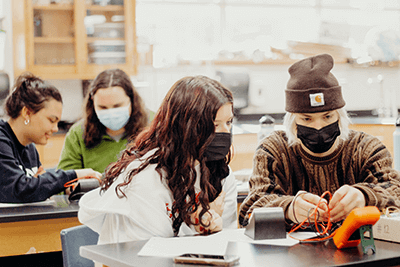March 31, 2022
 I enjoyed the opportunity last Friday to visit with fifth-graders about their SEEK (Science, Experiments, Explorations, and Knowledge) Projects. A tradition for more than 20 years, Middle School Science Teacher Courtney Nagle describes SEEK as “the scientific method on steroids!”
I enjoyed the opportunity last Friday to visit with fifth-graders about their SEEK (Science, Experiments, Explorations, and Knowledge) Projects. A tradition for more than 20 years, Middle School Science Teacher Courtney Nagle describes SEEK as “the scientific method on steroids!”
As I wandered around the Family Commons, I was impressed by the variety of scientific experiments students chose and was struck by their curiosity. In particular, I was delighted with their ability to critique their project, talk about what they would do differently next time, and how what they learned could be applied in other contexts. The SEEK Project is an excellent example of what we at MPA call “rigor with purpose.”
Rigor is different from difficulty. Traditional applications of rigor most often entail more and harder assignments that are “pushed down” from the teacher and “piled on” to the student. In reality, such an understanding of rigor requires little more than lower-level thinking skills such as factual recall and procedural regurgitation rather than greater cognitive complexity. At MPA, rigor with purpose is meaningful learning that goes deeper to challenge students’ thinking in new and exciting ways.
For kindergarten teacher Regina Santiago, rigor in kindergarten means students have experiences that cultivate their empathy and agency both as individual learners and as citizens of a larger community. She believes rigorous learning is process-oriented rather than product-oriented, and student-driven rather than teacher-centered. Quality over quantity, depth over breadth. Regina sees her role in creating the environment, modeling, and providing guidance to help kids do what they do best—learn through play.
Rigor with purpose is also rigor that matters. Contrary to many interpretations, rigor is not the memorization of esoteric knowledge. Instead, MPA teachers foster the ability of students to transfer knowledge learned in one context to solve authentic, real-world problems in novel ways. It is also student-centered, not teacher-centered, so that students are empowered to be architects of their learning, capable of embodying a desire to learn unmatched by any that could be instilled by a parent or teacher.
Middle School teacher John Milam is intentional about applying content to solving real-world problems. For example, seventh-grade students are currently studying Newton’s Laws of Motion and Forces. Students must apply these concepts to designing and building the fastest possible CO2 dragsters. Their dragsters will reach speeds of 45-50 mph and the difference between winning a heat and coming in second will be a matter of 100ths of a second. Students who truly understand force and motion, aerodynamics, the impact of mass on inertia, will be the students who can design and build the fastest dragsters.
Furthermore, rigor with purpose is rigor that is needed. This involves not just student-centered transfer and application of knowledge, but is authentically creating knowledge collaboratively. Rigor that is needed relies upon the interdependency of teachers and students who form authentic relationships that lead to the appreciation of diverse perspectives.
In Upper School, social studies teacher Katie Murr and English teacher Sara Mohn created an interdisciplinary American Studies course that combines both English and social studies for all eleventh graders. The course asks students to analyze the historical events that shaped the history of the United States through the complex lens of period literature while prompting them to make connections to the larger world and current events. Taking a chronological approach beginning with indigenous cultures and continuing to the present day, the course ensures students gain a deep understanding of the nuanced history of the United States through literature-based units.
Rigor with purpose leads to greater student engagement. “Teachers understand that they aren’t just teaching for us to get through high school but they’re teaching the next generation of change-makers,” according to senior Lucia Simon. “Everything they teach, they show us why we should care about it and why it’s useful in the world.” Encouraging students to use both their minds and their hearts is why rigor with purpose prepares them to truly dream big and do right. Rigor with purpose leads to greater student engagement. “Teachers understand that they aren’t just teaching for us to get through high school, but they’re teaching the next generation of change-makers,” said senior Lucia Simon. “Everything they teach, they show us why we should care about it and why it’s useful in the world. For Spanish teacher Kari Kunze, “when rigor is set appropriately, joy follows. A thought-provoking class makes students WANT to learn more.” She says. “Everybody likes to feel smart and accomplished. When students feel like they are on the path toward that accomplishment, they feel great because they know they have earned it and have been supported along the way.”